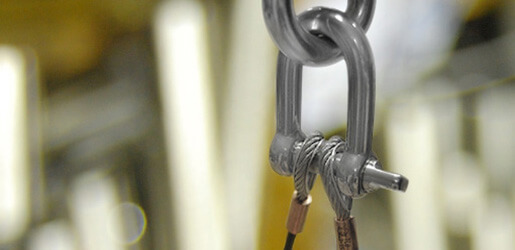Lifting shackles are fundamental components in various industries, ensuring the safe and efficient handling of loads. Choosing the right lifting shackle is crucial for the safety, reliability, and efficiency of lifting operations. This guide provides a detailed exploration of the key considerations when selecting the appropriate lifting shackle for your needs.
Understanding Lifting Shackles
Lifting shackles are U-shaped metal pieces with a pin or bolt across the opening. They are used to connect lifting equipment, such as chains, ropes, and slings, to loads. Shackles come in various types, each suited for specific applications and load capacities. The most common types include anchor (or bow) shackles and chain (or D) shackles.
Key Considerations for Selecting Lifting Shackles
1. Load Capacity
The foremost consideration when choosing a lifting shackle is its load capacity, also known as the Working Load Limit (WLL). This is the maximum load that the shackle can safely lift. It's crucial to select a shackle with a WLL that meets or exceeds the load you intend to lift. Overloading a shackle can lead to failure, posing significant safety risks.
2. Material and Construction
The material and construction of the shackle significantly affect its strength, durability, and resistance to environmental factors. Common materials used in shackle manufacturing include carbon steel, alloy steel, and stainless steel.
- Carbon Steel: Known for its strength and affordability, carbon steel is suitable for general lifting applications.
- Alloy Steel: Offers enhanced strength and is ideal for heavy-duty applications.
- Stainless Steel: Provides excellent resistance to corrosion, making it suitable for marine environments or where exposure to harsh chemicals is a concern.
3. Shackle Type
Different types of shackles are designed for specific applications:
- Anchor (Bow) Shackles: These have a larger, rounded bow, allowing them to handle multiple slings and loads from different angles. They are versatile and commonly used in lifting, towing, and rigging operations.
- Chain (D) Shackles: These have a narrower, D-shaped design, which makes them suitable for straight-line pulls. They are often used in applications where the load direction is consistent.
4. Pin Type
The pin is a crucial component of the shackle, as it secures the load. The two main types of pins are screw pins and bolt-type pins:
- Screw Pins: These are easy to install and remove, making them suitable for temporary or frequently adjusted lifting operations.
- Bolt-Type Pins: These provide a more secure connection, with a nut and cotter pin ensuring the pin cannot unscrew accidentally. They are ideal for permanent or long-term lifting applications.
5. Size and Dimensions
Selecting the right size and dimensions of the shackle is essential for compatibility with other lifting equipment. Key dimensions to consider include the diameter of the bow, the width of the jaw opening, and the pin diameter. Ensure the shackle fits properly with the hooks, chains, or slings you are using to avoid mismatches that could compromise safety.
6. Safety Standards and Certifications
Adhering to safety standards and certifications is vital in ensuring the reliability and quality of the shackle. Look for shackles that comply with recognized standards, such as those set by the American Society of Mechanical Engineers (ASME), the European Committee for Standardization (CEN), or other relevant bodies. Certified shackles have undergone rigorous testing to meet specific safety and performance criteria.
7. Environmental Considerations
The operating environment can significantly impact the performance and lifespan of a shackle. Factors such as temperature extremes, exposure to chemicals, and presence of moisture should be considered:
- Corrosive Environments: Stainless steel or galvanized shackles are recommended for environments where corrosion is a concern.
- High-Temperature Environments: Shackles made from alloy steel can withstand higher temperatures without losing strength.
- Subzero Environments: Certain materials maintain their toughness in low temperatures, ensuring safety and performance.
8. Inspection and Maintenance
Regular inspection and maintenance are crucial for ensuring the longevity and safety of lifting shackles. Before each use, check for signs of wear, deformation, corrosion, or damage. Periodic inspections by a qualified professional can help identify potential issues before they lead to failure. Proper lubrication of moving parts and adherence to manufacturer guidelines will enhance the shackle's durability.
9. Ease of Use
Consider the ease of use when selecting a shackle. Features such as quick-release pins, easy-to-read markings for load capacity, and ergonomic designs can enhance efficiency and reduce the risk of operator error. Choosing shackles that are user-friendly can streamline lifting operations and improve overall safety.
10. Cost vs. Quality
While cost is an important factor, it should not be the sole determinant in choosing a lifting shackle. Investing in high-quality shackles from reputable manufacturers ensures reliability, safety, and longer service life. Balancing cost with quality considerations will provide better value in the long run, reducing the likelihood of accidents and equipment failure.
Conclusion
Selecting the right lifting shackle involves careful consideration of various factors, including load capacity, material, type, pin design, size, safety standards, environmental conditions, and ease of use. Ensuring that the shackle is appropriate for the specific lifting application and operating environment is paramount for safety and efficiency. By adhering to these key considerations, you can make informed decisions that enhance the performance and safety of your lifting operations. Always prioritize quality and adherence to safety standards to mitigate risks and ensure the longevity of your lifting equipment.





Comments